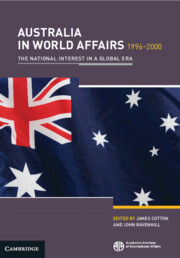Book contents
- Frontmatter
- Contents
- Figure
- Contributors
- Preface
- Abbreviations
- Part I Setting the Scene
- Part II Relationships
- Part III Issues
- 11 Facing an Uncertain Future: Defence and Security under the Howard Government
- 12 The East Timor Commitment and Its Consequences
- 13 Australia in World Environmental Affairs
- 14 Australia and the International Human Rights Regime1
- 15 Australia and the Global Economy
- 16 Australia and the Asian Economic Crisis
- References
- Index
15 - Australia and the Global Economy
from Part III - Issues
Published online by Cambridge University Press: 04 May 2024
- Frontmatter
- Contents
- Figure
- Contributors
- Preface
- Abbreviations
- Part I Setting the Scene
- Part II Relationships
- Part III Issues
- 11 Facing an Uncertain Future: Defence and Security under the Howard Government
- 12 The East Timor Commitment and Its Consequences
- 13 Australia in World Environmental Affairs
- 14 Australia and the International Human Rights Regime1
- 15 Australia and the Global Economy
- 16 Australia and the Asian Economic Crisis
- References
- Index
Summary
The Australian economy performed surprisingly strongly throughout most of the five-year period under consideration. The performance was surprising, that is, given the troubles – concentrated in the years 1997–99 – that afflicted most East Asian economies, which together account for more than half of Australia’s exports. By the end of the five-year period, however, the triumphalism that had accompanied Australian official reaction to the Asian economic crisis began to look premature. In 1999–2000, the government had to apply the brakes (in the form of higher interest rates) to the economy largely because of external constraints: a worsening current account deficit and a depreciating currency. The economy was showing all-too-familiar signs of the stop–go pattern that had choked off growth in earlier periods. Fears were mounting that the economic growth that had occurred throughout the period – the country’s longest boom since the 1960s – was drawing to an end.
Keywords
- Type
- Chapter
- Information
- Australia in World Affairs 1996–2000The National Interest in a Global Era, pp. 193 - 207Publisher: Cambridge University PressFirst published in: 2024

